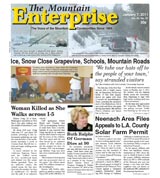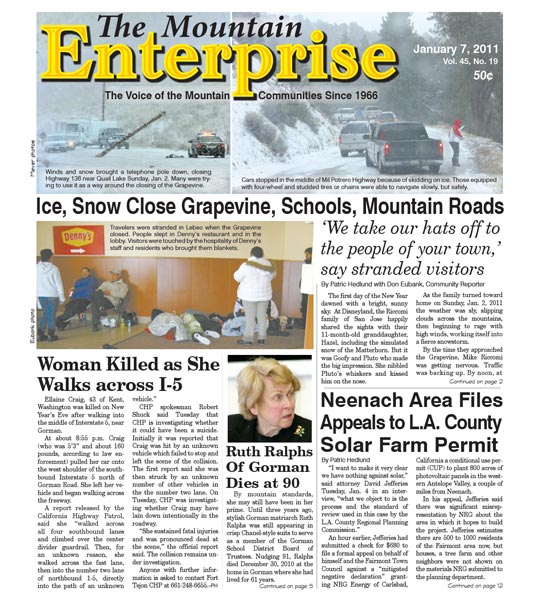By Patric Hedlund
“I want to make it very clear we have nothing against solar,” said attorney David Jefferies Tuesday, Jan. 4 in an interview, “what we object to is the process and the standard of review used in this case by the L.A. County Regional Planning Commission.”
An hour earlier, Jefferies had submitted a check for $680 to file a formal appeal on behalf of himself and the Fairmont Town Council against a “mitigated negative declaration” granting NRG Energy of Carlsbad, California a conditional use permit (CUP) to plant 800 acres of photovoltaic panels in the western Antelope Valley, a couple of miles from Neenach.
In his appeal, Jefferies said there was significant misrepresentation by NRG about the area in which it hopes to build the project. Jefferies estimates there are 500 to 1000 residents of the Fairmont area now, but houses, a tree farm and other neighbors were not shown on the materials NRG submitted to the planning department.
“All the photos they submitted were taken in 2006 and before,” he said, “there have been significant changes to this region since then.”
The “negative declaration” status let the company avoid the need for environmental impact review (EIR) studies and public hearing requirements mandated by the California Environmental Quality Act (CEQA). Just days before Christmas, “a PR man showed us a very incomplete application that wasn’t even printed out in hard copy yet,” Jefferies said. The CUP was granted on December 21, 2010. The deadline for the public to lodge a protest appeal was January 4, 2011.
A second appeal was lodged by two other groups: Friends of Antelope Valley Open Space and Westside Concerned Citizens. They filed their appeal on January 3.
“We want to set some standards and criteria for how these projects are going to be handled,” Margaret Rhyne said. She said that the $680 for their filing was raised in “grassroots donations of $25, $50, a little bit from a lot of different people. A lot of people are upset about the way this was done.”
Jefferies and Rhyne both said they believe that an EIR should be required for the project. They mentioned an earlier project, NexLight, also known as AV Solar 1, “which had good communication with the communities, did an EIR and worked with their neighbors.”
Jefferies said that the NRG project had presented “no studies about the light pollution, drainage, grading and impacts on wildlife, habitat or foliage” for review by the neighboring residents. Rhyne said that no cumulative impact analysis has been done by the county.
A tree farmer, whose family’s property is adjacent to the proposed NRG facility near Avenue 190, also spoke of concerns regarding the cumulative impact “when there are 13 or 14 of these alternative energy facilities here—there are that many being planned now.”
“I am concerned that they [NRG] are draining their stuff on my property; that will mess me up in a flood,” he said.
The NRG application didn’t mention there were neighbors, the farmer said, adding that no neighbors had been notified of the project.
He said there needs to be an environmental impact review: “there will be 350-400 people on this [NRG] job, and 600 people on the NexLight project. That will be good for the stores around here, which I like; but these are construction workers— I was one myself, I know what I’m talking about. This is open area. They will come blowing in here, bringing out their guns for shooting after work and dirt whomping, raising dust. I want to address that on the EIR and be sure we have some respect for this area.”
This is part of the January 07, 2011 online edition of The Mountain Enterprise.
Have an opinion on this matter? We'd like to hear from you.


